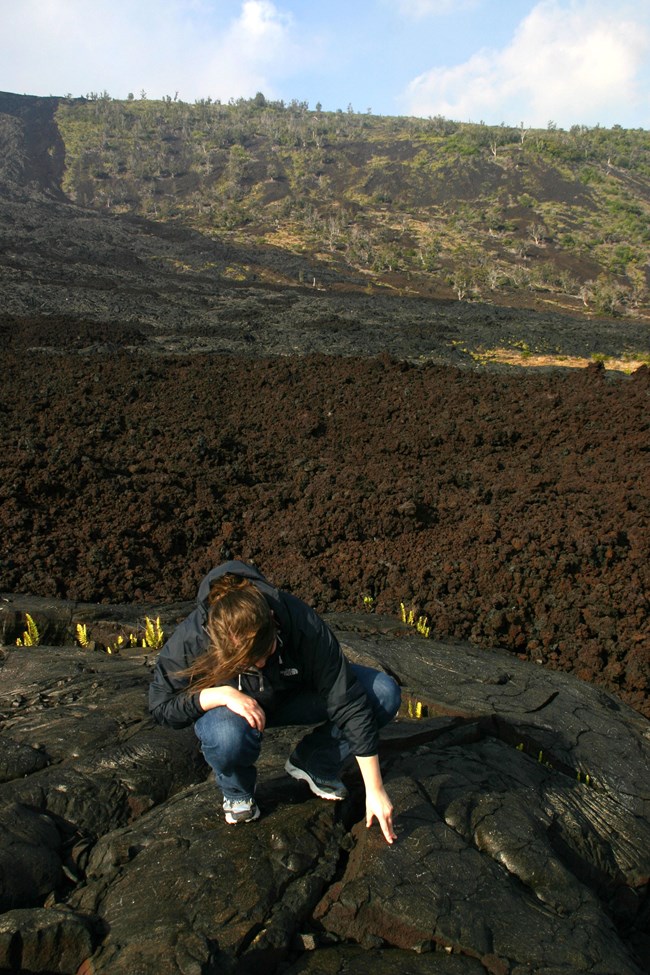Last updated: July 5, 2024
Article
NPS Geodiversity Atlas—Hawai'i Volcanoes National Park, Hawai'i
Geodiversity refers to the full variety of natural geologic (rocks, minerals, sediments, fossils, landforms, and physical processes) and soil resources and processes that occur in the park. A product of the Geologic Resources Inventory, the NPS Geodiversity Atlas delivers information in support of education, Geoconservation, and integrated management of living (biotic) and non-living (abiotic) components of the ecosystem.

Introduction
Hawai‘i Volcanoes National Park (HAVO) is located on the southern end of the island of Hawai‘i, the southernmost and largest island of the Hawaiian Archipelago. Originally established as part of Hawai‘i National Park on August 1, 1916, the park was renamed on September 22, 1961, and designated a Biosphere Reserve in 1980 as well as a World Heritage Site in 1987 (National Park Service 2016). HAVO encompasses approximately 130,887 hectares (323,431 acres) of public land that includes unique geologic, biologic, and cultural landscapes. The park was established to protect, study, and provide access to Kīlauea and Mauna Loa, two of the world’s most active volcanoes, and preserve native Hawaiian ecosystems and the traditional Hawaiian culture connected to these landscapes (National Park Service 2017b). The summit of Mauna Loa, active volcanism, rare and endangered biological communities, and prehistoric sites are among some of the special features within HAVO.
Geologic Setting
The geology of HAVO is dominated by young (<2,000 years old) igneous rock units that include lava flows and vent deposits that originated from the active volcanic centers of Kīlauea and Mauna Loa. Dynamic geologic processes such as volcanism, mass wasting (landslide or slope movement), and seismicity are constantly reshaping the terrain of HAVO over a relatively short time scale. The park landscape consists of relatively barren, fresh lava flow areas, Kīlauea, the gentle slopes of Mauna Loa, and coastal areas where basalt flows form broad slopes and terraces separating sheltered coves along the shore (Thornberry-Ehrlich 2009). Beach areas within HAVO contain intertidal- to supratidal accumulations of black basaltic sand, green olivine sand, and coralline sediments derived from storms and marine highstands, as well as eolian (wind-driven) sand deposits. Natural features at HAVO include stark volcanic flow fields, ephemeral streams cutting narrow gorges, fresh volcanic deposits, cinder cones, numerous small craters, broad vegetated slopes, and a variety of unique and native Hawaiian ecosystems (Thornberry-Ehrlich 2009).
Paleontological Resources
All NPS fossil resources are protected under the Paleontological Resources Preservation Act of 2009 (Public Law 111-11, Title VI, Subtitle D; 16 U.S.C. §§ 470aaa - 470aaa-11).
Cave and Karst
All NPS cave resources are protected under the the Federal Cave Resources Protection Act of 1988 (FCRPA)(16 U.S.C. § 4301 et seq.).
- Scoping summaries are records of scoping meetings where NPS staff and local geologists determined the park’s geologic mapping plan and what content should be included in the report.
- Digital geologic maps include files for viewing in GIS software, a guide to using the data, and a document with ancillary map information. Newer products also include data viewable in Google Earth and online map services.
- Reports use the maps to discuss the park’s setting and significance, notable geologic features and processes, geologic resource management issues, and geologic history.
- Posters are a static view of the GIS data in PDF format. Newer posters include aerial imagery or shaded relief and other park information. They are also included with the reports.
- Projects list basic information about the program and all products available for a park.
Source: NPS DataStore Saved Search 2896. To search for additional information, visit the NPS DataStore.
A NPS Soil Resources Inventory project has been completed for Hawai'i Volcanoes National Park and can be found on the NPS Data Store.
Source: NPS DataStore Saved Search 2967. To search for additional information, visit the NPS DataStore.

Related Links
Related Articles
Hawai'i Volcanoes National Park
National Park Service Geodiversity Atlas
The servicewide Geodiversity Atlas provides information on geoheritage and geodiversity resources and values within the National Park System. This information supports science-based geoconservation and interpretation in the NPS, as well as STEM education in schools, museums, and field camps. The NPS Geologic Resources Division and many parks work with National and International geoconservation communities to ensure that NPS abiotic resources are managed using the highest standards and best practices available.

